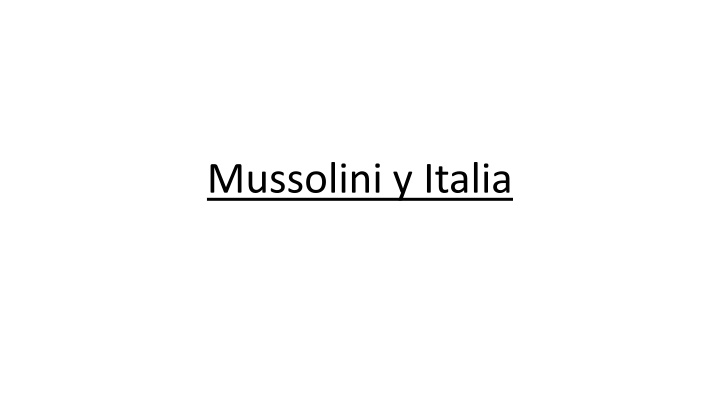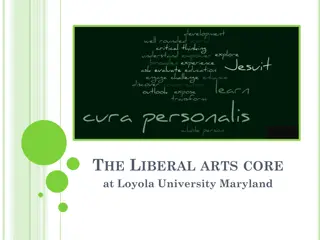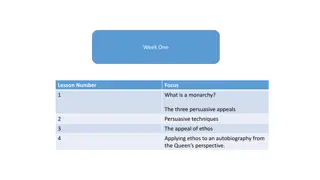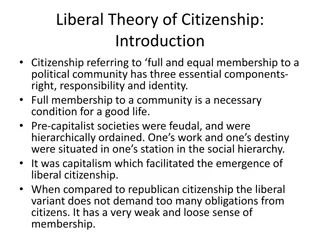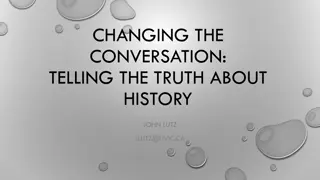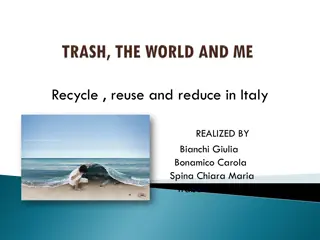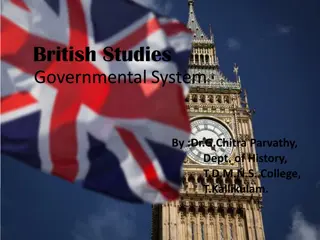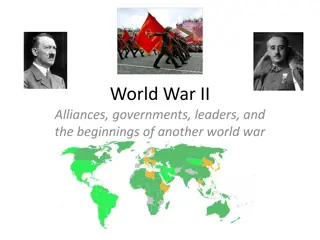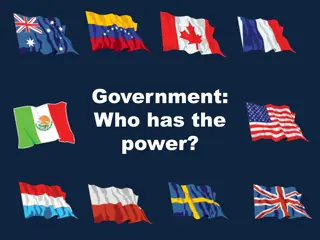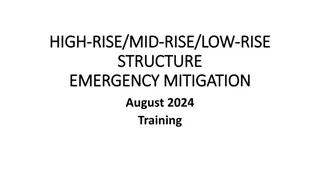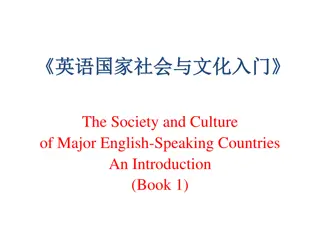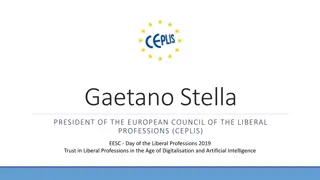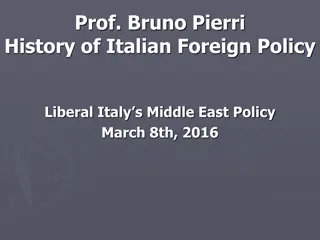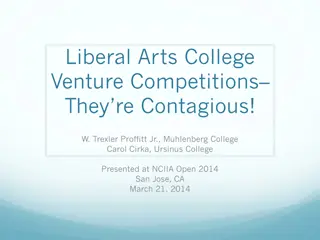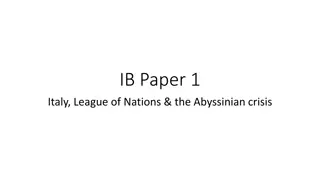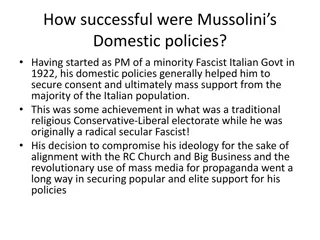Rise of Mussolini in Italy and Weaknesses of the Liberal Monarchy
The historical timeline of Italy before 1919 led to Mussolini's rise to power through various events such as his involvement with the Italian Socialist Party and the formation of the Fascio di Combattimento. Italy's Liberal Monarchy faced weaknesses, including political divisions between progressives and conservatives, limited voting rights, and challenges from socialist and anarchist movements. These factors contributed to the social and political climate that enabled Mussolini's ascent to leadership.
Uploaded on Sep 20, 2024 | 4 Views
Download Presentation

Please find below an Image/Link to download the presentation.
The content on the website is provided AS IS for your information and personal use only. It may not be sold, licensed, or shared on other websites without obtaining consent from the author.If you encounter any issues during the download, it is possible that the publisher has removed the file from their server.
You are allowed to download the files provided on this website for personal or commercial use, subject to the condition that they are used lawfully. All files are the property of their respective owners.
The content on the website is provided AS IS for your information and personal use only. It may not be sold, licensed, or shared on other websites without obtaining consent from the author.
E N D
Presentation Transcript
Timeline David Li
Timeline of Events 1861 Formation of an independent Italy achieved large by a small nationalist movement. Key people: Count Camillo di Cavour, Giuseppe Mazzini, Giuseppe Garibaldi and Victor Emmanuel II 1870 Papal states incorporated into Italian kingdom. Led to banning of Catholics from all involvements in politics in Italy 1904 General strike. Many emigrated, mainly to the US. 1909 Sep Mussolini begins work as member of Italian Socialist Party 1911 Sep Italy invades Libya to increase the size of the Italian empire and to block growing French influence in North Africa 1912 Nov Mussolini appointed editor of Socialist Party newspaper, Avanti!
Contd 1914 Jun Red Week Oct Mussolini expelled from Socialist Party Nov Mussolini founds Il Popolo d Italia 1915 May Italy signs Treaty of London; participation in First World War leads to huge loss of population and inflation; mutilated victory 1919 Jan start of biennio rosso (the 2 red years); first Arditi Association set up in Rome, used weapons to attack socialists and trade unionists Mar formation of the Fascio di Combattimento ('fighting group'), the founding members were later known as the Fascists of the First Hour. Intended to bring together nationalists and socialists Sep D Annunzio takes Fiume
Contd 1920 Sep wave of factory occupations; electoral victories for socialists 1921 May Mussolini forms National Bloc electoral alliance with Giolitti; 35 fascists elected, including Mussolini Aug Pact of Pacification between fascists and socialists Oct formation of PNF Nov Mussolini elected leader of PNF 1922 Jul Aug general strike broken up by fascist violence Oct March on Rome; Mussolini appointed as PM
How did the historical context of Italy before 1919 contribute to Mussolini s rise to power?
Weaknesses of Italys Liberal Monarchy In 1871, Risorgimento, a nationalist movement succeeded in creating a unified Italy. The Liberals sought to reform Italy State education to combat the influence of the Catholic church Stimulating economic development and progress The liberals were split into progressives ( left-liberal ) and conservatives ( conservative liberals ) Feared the socialists, anarchists and republicans (left) and the church (right) Initially, only 2% of the adult population was allowed to vote Italians felt resentment against restricted franchise (right to vote) So the liberal politicians formed deals with one another to alternate political control transformismo By 1912, all adult males were allowed to vote, through transformismo continued Hostility of the papacy (church) towards the new Italian State
Regional Divisions Many Italians were more loyal to their region or town rather than the national government Italy s mountain ranges made communication difficult No true national identity Northern / Central: developed, more modern, machinery was used for farming, still massive land owned by wealthy landowners (agrari), conflict and discontent South: poor, agricultural, most of the fertile lands were part of latifundia, which were owned by a few wealthy landowners. Majority was poor Industrial economic Difference
The South V.S. the North The Fiat Car Company: established in 1899, brought prosperity and development to the north No real investment in the South Increased the economic Frequent clashes between employees and employers Workers joined the socialists or anarchist or migrated to the US
Terra Irredenda Land in Europe that Italy claimed the right for Germany was successful after being created in 1871, Italy wanted land too Acquisition of the port of Mossawwa on the Red sea (1885) Italy began to conquer Italian Somaliland, but tensions grew between Italy and Abyssinia Defeat in 1896 made Italians press for a more aggressive imperial policy Italy invaded the Turkish colony of Libya (1911), turkey accepts defeat in 1912
The Treaty of London The Treaty of London Intervention V.S. Neutrality Intervention V.S. Neutrality Fasci a mixture of anarcho- syndicalist Interventions organized demonstrations to demand Italy s involvement in the war Liberal politicians decided on Italy s participation in war 1915: Treaty of London promised Italy s participation Majority Italians / Socialists: Neutrality Nationalist: felt the need to intervene to reclaim Terra Irredenda Italy was promised a lot of land if they win (Trentino or Trieste (Austrian Territory) and Istria and northern Dalmatia on the Adriatic coast.
Economic Impact WW1 Liberal government borrowed heavily from UK and US for the war 1915-1918: prices rose more than 400% During the last years of war, the government promised to reform the land after the war Costly (money and in casualty) November 1917: suffers terrible defeat Octomber 1918: Wins Vittorio Vento but was overshadowed by previous defeats Nationalists blamed government for failures.
Peace Treaties and Discontent Peace Conference 1919 Italy went and expected to get all that she has requested before the war However, she gained no African Territory, UK/US refused to give Fiume and northern Dalmatia (basically taken by Yugoslavia, a new state) AH was defeated and Italy had control over the Adriatic, but the government was blamed of Italy being humiliated and cheated mutilated victory
What were the key stages in Mussolini s rise to power in the period 1919 22?
Post WWI The liberal regime faced many difficulties post WWI. In addition to the growing dissatisfaction of the nationalists, the liberals faced increased political opposition from other quarters. January 1919 - foundation of the Partito Popolare Italiano (PPI), or Italian Popular Party. (During the downfall of the liberals). More serious threat to liberal regime - The Italian socialist party
Continued Economic problems post WWI caused great discontent among rural and industrial workers. Socialist party move to a more revolutionary position.
The Biennio Rosso - 191920 (The two red years) Unemployment rose to over 2 million in 1919 Throughout 1919, strikes, factory occupations and land occupations, organized by trade unions and peasant leagues and involving over 1 million workers, swept across Italy. In many areas, especially in the north, socialists seized control of local government.
Continued The threat of a communist revolution In response to riots the government did very little. This lack of forceful action led many of the middle and upper classes to view the government as dangerously incompetent. After the war, the various militant and disaffected right-wing groups were joined by another force that was also in search of change.
Continued These groups comprised of unemployed officers and troops, who found it difficult to accept many aspects of post-war Italian society. One notable group was the Arditi. In March 1919, Mussolini himself a member of the Arditi tried to bring these groups together. On 23 March, 118 people, representing various political groupings, met in Milan and formed a Fascio di Combattimento (Known as the Fascists of the first hour).
Continued Lack of popularity in the first proportional representation elections (very few dedicated fascists in italy during 1919) However, the unrest of the biennio rosso gave a boost to Mussolini s organisation. Facsist popularity had increased since the last elections gainging 35 seats in the 1921 national election.
Continued Mussolini himself was now a deputy and, significantly, all 35 fascist deputies were from the right of the movement. More importantly, holding positions in parliament gave the fascists an image of respectability as well as a foothold in national politics.
How was Mussolini Able to Rise to Power?
General Factors Political instability three weak coalition governments, none of which took action against industrial struggles and political violence Attitude of political elites police and army leaders let the violent Fascist forces slip some provided transport to help them! Sqaudristiforces ( black shirts ) militant force which followed Mussolini s order on the underhand occasionally worried Mussolini because they were violent yet incohesive
His Steps (Pact of pacification & formation of PNF) Mussolini signed pact of pacification with moderate socialists and the main trade union organisation CGL, angering the ras and receiving support from the conservative elites Then he resigned and reformed the PNF in order to oust the ras out of his party and solidify his power. Then he regained his power by persuading the Fascist National Congress to elect him as leader. Now the ras lost their voice and Mussolini solidified his power
His Steps (gaining support from moderation) Mussolini wanted support from the church and so dropped the left-wing elements Pius XI did not support Popolari (Catholic Party) but blesses Fascist banners He kept policy statements vague to gain support mostly from shopkeepers and clerical workers
His Steps (Fascist violence) The ras, especially Farinacci and Balbo, constantly endorsed the idea of violent seize of power Mussolini did not want power within his party splitting nor did he want to lose support from the elites He thus decided to internally support militant actions and externally condemn them or at least feign as if he did not support them When socialists started a strike, Mussolini used this fact to prove that Socialists were a threat and broke the strike The incident impressed moderate liberals and conservative middle classes, renewing relationships between Mussolini and former liberal PMs
His steps (the March on Rome) Balbo told Mussolini the ras are planning to advance to Rome with or without him. Mussolini agreed to organise the march on Rome. During the march, PM Luigi Facta persuaded the king to declare a state of emergency to use the military and police to stop Mussolini. Fascists forces were stopped but the prefect of Milan hid Mussolini King decided not to arrest him but offer his party seats in the cabinet Mussolini refused to take the proposal and Salandra advised the king to appoint him as PM So appointed
Conclusion Mussolini was able to rise to power because Historical Context - Regional differences - Discontent of the citizens about the peace treaties - Weaknesses of liberal regime Key Stages (evidence) - Rise of Popolari in 1919 (downfall of liberal regime) - Biennio Rosso (the two red years) - Formation of Fascio di Combattimento (Fascists of the first hour) Tactics - Pact of pacification and formation of PNF - Gaining support from moderation - Fascist Violence (the March on Rome)
Key Terminology (1) Fascism: A form of radical right-wing government associated with authoritarianism and nationalism. On the far-right spectrum. Originated in Italy during World War I and influenced by national syndicalism Transformismo: The method of establishing a centrist government isolating extreme rightist and leftist politics in Italy after the unification and before the rise of Mussolini. Arditi: The elite storm troops of the Royal Italian Army during WWI. Translates to the daring ones . They were opposing the liberal government because they believed that their wartime sacrifices were overlooked by not obtaining the land Italy was promised. Demobilized in 1920. Fasci Italiani di Combattimento (FIC): The Italian Fascist of Combat, until 1919 called Fascist of Revolutionary Action, was an Italian fascist organization, created by Benito Mussolini in 1914. Split from the Socialist Party and later merged into the National Fascist Party. National Fascist Party: The ruling party of the Kingdom of Italy from 1922-43. Benito Mussolini founded the party in 1919 and served as its Chairman from 1919-43. The Party thrived after Mussolini led thousands of Blackshirts in the March on Rome and forced King Victor Emmanuel III to appoint him Prime Minister. As the head of state with true power, Mussolini established a one-party police regime, which lasted until Mussolini was stripped of power by his own people and ordered to be arrested by the King in 1943. After his capture, the National Fascist Party was destroyed. March on Rome: The March on Rome was a march by which Mussolini's National Fascist Party came to power in Italy. The March took place from 22 to 29 October 1922. Similar with Hitler's Beer Hall Putsch. Blackshirts: Also known as the Squadristi. Parallel to Hitler's SA
Key Terminology (2) Squadrismo: Consisted of fascist squads who were led by the Ras from 1918-24. It developed from the inspiration many Ras leaders found from Mussolini, but was not directly controlled by Benito Mussolini. Mainly used to spark fear and combat the growing Socialist movement which was a big opponent of Fascism. Avanti: Italian newspaper published since 25 December 1896. Advocated neutrality after WWI but became infused with militarist views by its editor Mussolini. As a result he was exiled from the Socialist party and created his own newspaper, Il Popolo d'Italia. Red Week: A week of civil unrest which occurred in June 1914. There was widespread rioting and strikes throughout the Italian provinces Romagna and the Marche. Il Popolo d Italia: "The People of Italy" was an Italian newspaper founded by Benito Mussolini in 1914, after his split from the Italian Socialist Party. Used by Mussolini to increase the birth rate, etc. Treaty of London (1915): A secret pact between the Triple Entente and Italy, signed in London on 26 April 1915 by the UK, France, Russia, and the Italy. Attempt to turn Italy against former allies such as Germany and AH. Italy was to leave the Triple Alliance and join the Triple Entente (Britain, France and Russia). Promised land to Italy if they had victory Biennio rosso (1919-20): The "Red Biennium" or the "Two Red Years" was a time of intense social conflict in Italy, following the First World War. Followed by the violent reaction of the Fascist blackshirts militia and eventually by the March on Rome of Benito Mussolini in 1922. Risorgimento: Italian unification. Merged different Italian states into one in the late nineteenth century. Terra irredenta: Means unredeemed land . Territorial disputes between AH and Italy
Key Terminology (3) Triple Alliance (1882): Alliance between Germany, Austria and Italy Associazione Nazionalista Italiana (ANI): Formed in 1910, Italy's first nationalist party. Advocated war with AH to gain the terrairredenta. Merged with the National Fascist Party in 1923. Attrition: The process of wearing down the enemy by steady killing. Italian officers often sacrificed thousands of lives needlessly in all, over 600,000 Italians were killed, about 450,000 permanently disabled, and a further 500,000 seriously wounded. Bolsheviks: The more revolutionary element of the Russian Social Democratic Labor Party (a Marxist party). Led by Lenin and later joined by Leon Trotsky, who both took power in Russia in November 1917. The Bolsheviks later changed their name to the Russian Communist Party, and worked hard to aid and encourage socialist revolutions in other regions, especially in more advanced capitalist countries such as Germany. Partito Popolare Italiano (PPI): Combination of liberal and conservative Catholics who defended Catholic interests. Opposed the Italian Socialist Party and supported by Pope Benedict XV. Won 20% of the vote in 1919-21 and second largest party after the Socialist. Syndicalist: People who believed that workers should control the economy through trade unions, instead of the state. Some evolved into fascists. Ras: The Abyssinian word meaning chieftain . Regional fascist leaders who commanded their own action squads
Key People (1) Benito Mussolini: Grew up to be influenced by his socialist father. Went into politics and journalism. Between 1904 and 1910, he was viewed as a militant due to his socialist views in articles. WWI made him extremely nationalistic and therefore we was expelled from the Italian Socialist Party and created fascism. Ruled Italy from 1922 to 1943. Gabriele D Annunzio (1863 1938): Poet and writer. Ultra nationalist and supported Italy's entry in WWI on the side of the Triple Entente. Was a pilot and dropped propaganda leaflets in Austria - thus viewed as a war hero. Vittorio Orlando (1860-1952): Italian diplomat and political figure. Represented Italy in the Paris Peace Conferences. Giovanni Giolitti (1842 1928): Prime minister of Italy five times between 1892 and 1921. Opposed Italy's entry in WWI. Supported by the squadristi and did not oppose their violence. Supported Mussolini at first but drew back in 1924. Filippo Tommaso Marinetti (1876 1944): Writer and artist. Early supporter of Mussolini. He later went away from what he viewed as the more conservative aspects of fascism, but still nevertheless was an important influence on it.
Key People (2) Italo Balbo (1896 1940): A right-wing republican, Balbo joined the National Fascist Party in 1921. He became the ras of Ferrara. One of the four main planners of the March on Rome. In 1923, he became a member of the Fascist Grand Council. Roberto Farinacci (1892 1945): Initially a radical nationalist, but soon became involved in the emerging fascist movement. The ras in Cremona, publishing his own newspaper and his action squads were among the most brutal in 1919. Ant-clerical and anti-semitic. Luigi Facta (1861 1930): Had liberal views. He initially favoured neutrality, but later supported the war effort of WWI. Facta became prime minister in February 1922. Dismissed in July, he was soon reappointed, as no one else could form a government. He was the last prime minister of Italy before Mussolini began his rule. Victor Emmanuel III (1869 1947): Victor Emmanuel was the last king of Italy, largely due to his role during the rise and rule of fascism. Appointed Mussolini as Prime Minister and condoned his violence. In June 1946, he went into exile in Egypt
